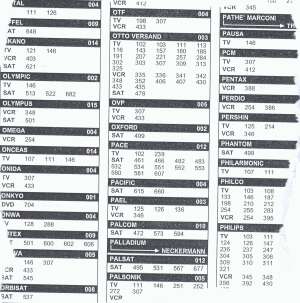Universal IR Remote Controllers
 Nowadays it is no surprise to find 4 or 5 different remote control units in an average living room.
TV, Stereo set, DVD player, VCR, Settop box and a Satellite receiver are among the most popular devices and each and every one of them has a unique remote control unit.
No wonder that people want to control all these devices with one single universal remote control unit.
Nowadays it is no surprise to find 4 or 5 different remote control units in an average living room.
TV, Stereo set, DVD player, VCR, Settop box and a Satellite receiver are among the most popular devices and each and every one of them has a unique remote control unit.
No wonder that people want to control all these devices with one single universal remote control unit.
Two major types of universal remote controllers exist: Learning controllers and Lookup Table controllers.
A combination of both types in one controller is also possible.
Both types have their own advantages and disadvantages.
What if you buy a universal remote controller and it appears that it can't simulate one of your controllers of brand X?
Bad luck, I should say.
And often the remote controller of brand X gets the blame for it, which is of course unjust.
I wrote this page to try to tackle some general misconceptions about universal remote controllers.
I'm often asked the question: "What code is used by the remote controller of brand X for device Y?".
If you read the rest of this page you'll notice that this is rather a silly question to ask.
Probably no one can answer that question.
Learning Universal Remote Controllers
This type of universal remote controllers has the ability to learn new codes. Usually you must align it head to head with the original remote controller and then press a special sequence of buttons on both controllers. The universal remote controller sees the patterns transmitted by the original remote controller and stores them in its memory. Later it can play back the learned patterns when you press the keys on the universal remote controller.
One of the biggest advantage of this approach is that the universal remote controller can learn codes of brand new remote controllers, which didn't exist yet when the universal remote controller was created.
But that doesn't mean that a learning universal remote controller can learn just about every possible protocol.
I can imagine for instance that the ITT code will not be recognized because of the very short IR pulses it produces, whilst most universal remote controllers expect to see some sort of carrier in the range of 36 to 40kHz.
Other protocols may not be recognized because of less obvious technical reasons.
For instance the NRC17 code may cause some problems on some universal remote controllers.
If it does cause problems it is probably because every NRC17 command consists of at least 3 messages (Start, Command and Stop).
I can imagine that some learning universal remote controllers can get quite confused by these Start and Stop messages.
Lookup Table Universal Remote Controllers
 A lookup table universal remote controller uses lookup tables to simulate the original controllers (what a surprise!).
In order to program the universal remote controller you need to enter a special 3 or 4 digit code which can usually be found in a little booklet that came with the universal remote controller.
This code is internally translated into a protocol, and all keys of the universal remote controller are mapped to their corresponding commands.
A lookup table universal remote controller uses lookup tables to simulate the original controllers (what a surprise!).
In order to program the universal remote controller you need to enter a special 3 or 4 digit code which can usually be found in a little booklet that came with the universal remote controller.
This code is internally translated into a protocol, and all keys of the universal remote controller are mapped to their corresponding commands.
It is the manufacturer of the universal remote controller who creates the lookup table.
This makes the code table unique to that particular type of universal remote controller.
Thus there is no logical connection between the codes and the brands and models of original remote controllers they represent.
This hopefully explains why it is a rather silly question to ask me if I know what code you'll have to enter into your universal remote controller for your brand X model Y device.
I have absolutely no way of knowing that.
The major disadvantage of this sort of universal remote controllers is that devices which are younger than the universal remote controller are probably not supported by it, simply because the universal remote controller manufacturer can not implement something which doesn't exist yet.
Upgradable software in the universal remote controllers would be the best solution so that the manufacturer of the universal remote controller can implement new remote controllers.
Thus it is not brand X's fault that your universal remote controller is not as universal as you were made to believe it was.
Conclusion
You'll have to ask the manufacturer of your universal remote controller about the 3 or 4 digit code you'll have to enter to simulate one of your original remote controllers, not me, nor the manufacturer of the original remote controller! Only the manufacturer of your universal remote controller can tell you what code to use to simulate your original remote controller, if it is supported at all.
Original remote controllers do not use 3 or 4 digit codes to identify the protocol and key mapping. Only the lookup table universal remote controls use them, and they are manufactured by totally different companies which are in no way related to the original remote controller manufacturer.
